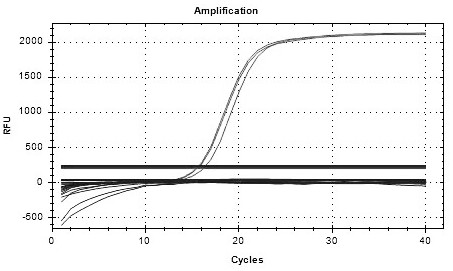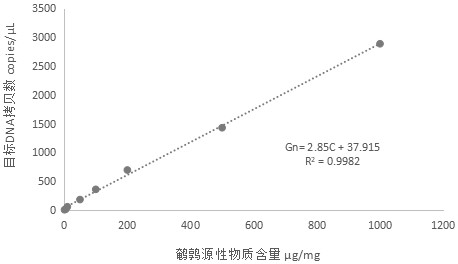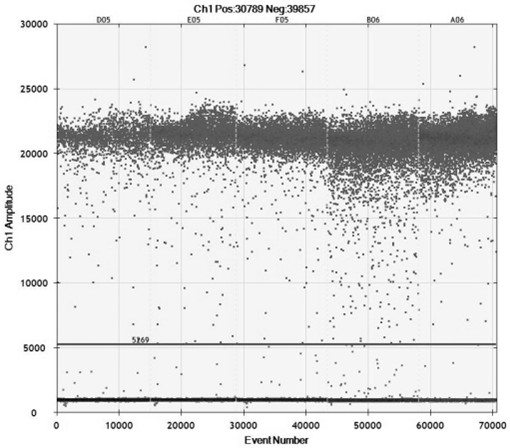Method for quantitatively detecting quail-derived components based on ddPCR technology
A technology derived from quail, applied in the field of molecular biology analysis, can solve problems such as inaccurate quantification and regulatory obstacles, and achieve the effects of convenient and fast determination process, good specificity and sensitivity, good repeatability and stability
- Summary
- Abstract
- Description
- Claims
- Application Information
AI Technical Summary
Problems solved by technology
Method used
Image
Examples
Embodiment 1
[0038] Embodiment 1: the design of primer probe
[0039] Primers and probes were synthesized by Nanjing GenScript Company.
[0040] For the single-copy gene design in the quail nuclear genome, the specific probe and primer sequences are as follows:
[0041] Probe: 5'-AGCAGCCAACACAGCACCCA-3', SEQ ID NO.1;
[0042] Upstream primer: 5'-ACAGCAACGTTTCTTCAGCTC-3', SEQ ID NO.2;
[0043] Downstream primer: 5'-CTGGGAGCGCTTGCTTTATT-3', SEQ ID NO.3;
[0044] The 5' end of the probe is modified with FAM, and the 3' end is modified with BHQ1; wherein, FAM represents a fluorescent reporter group, and BHQ1 represents a quencher group.
[0045] The present invention adopts the fluorescent probe method, and its detection principle is to identify templates by using fluorescently labeled specific probes. Compared with the SYBR dye method in the prior art, the fluorescence-labeled specific probe of the present invention has stronger specificity and lower background interference.
Embodiment 2
[0046]Example 2: Specific verification of primer probes
[0047] (1) Samples: The samples of quail meat, chicken, duck, goose, pigeon, lamb, beef and pork came from local farmers' markets in Nanjing.
[0048] (2) Reagents and instruments: DNA extraction kit was purchased from Tiangen Biochemical Technology (Beijing) Co., Ltd. Premix ExTaq (Takara, Japan); American Bio-Rad and CFX96 Touch fluorescent PCR instrument.
[0049] (3) Specificity verification: DNA from quail, chicken, duck, goose, mutton, beef, and pork was extracted as templates, and the primers and probes in Example 1 were used for QPCR amplification, and three samples were made for each sample. Repeat while ddH 2 O replaced the DNA template as a blank control group.
[0050] Amplification reaction system: Premix Ex Taq 12.5 μL, upstream and downstream primers 0.5 μL each, probe 1 μL, template 1 μL, ddH 2 O 9.5 μL.
[0051] The reaction conditions were: 95°C for 5 min; 95°C for 15 s, 60°C for 1 min, 40 cycles....
Embodiment 3
[0053] Example 3: Quail-derived ddPCR quantitative detection standard curve design and linear range verification
[0054] (1) Samples: The quail meat samples come from the local farmer's market in Nanjing. Divide the quail meat sample into small pieces of about 1 cm×1 cm×1 cm. Using vacuum freeze-drying technology, dry the sample at a vacuum degree of 0.100 mbar or less at -60°C for 48-72 h to reduce the moisture content in the sample. Effect of concentration of quail-derived components. After freeze-drying, the sample is ground into a powder sample by a tissue grinder to ensure the uniformity of the sample and avoid errors in quantitative results caused by uneven samples.
[0055] (2) Reagents and instruments: DNA extraction kit was purchased from Tiangen Biochemical Technology (Beijing) Co., Ltd. ddPCR amplification master mix ddPCR Super mix for Probes (Bio-Rad, USA); QX200 droplet digital PCR system and CFX96 Touch fluorescent PCR instrument of Bio-Rad in the United Stat...
PUM
 Login to View More
Login to View More Abstract
Description
Claims
Application Information
 Login to View More
Login to View More - R&D
- Intellectual Property
- Life Sciences
- Materials
- Tech Scout
- Unparalleled Data Quality
- Higher Quality Content
- 60% Fewer Hallucinations
Browse by: Latest US Patents, China's latest patents, Technical Efficacy Thesaurus, Application Domain, Technology Topic, Popular Technical Reports.
© 2025 PatSnap. All rights reserved.Legal|Privacy policy|Modern Slavery Act Transparency Statement|Sitemap|About US| Contact US: help@patsnap.com



